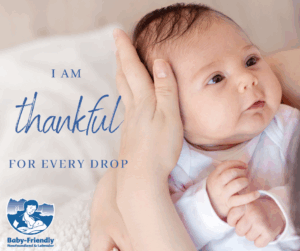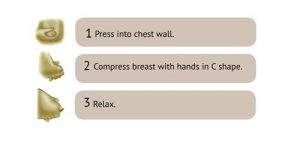Collecting Breastmilk in Pregnancy
 Did you know your body begins making breastmilk even before your baby arrives? As early as the 16th week of pregnancy, your body starts producing colostrum—the first form of breastmilk. Colostrum is sometimes called “liquid gold” because of its yellow colour and how important it is for your baby’s health. This early milk continues to be made right up until the first few days after birth.
Did you know your body begins making breastmilk even before your baby arrives? As early as the 16th week of pregnancy, your body starts producing colostrum—the first form of breastmilk. Colostrum is sometimes called “liquid gold” because of its yellow colour and how important it is for your baby’s health. This early milk continues to be made right up until the first few days after birth.
Once you reach 36 weeks of pregnancy and after discussing it with your health-care provider, you can begin collecting and storing colostrum for your baby.
Why colostrum is important for your baby
- It’s easy for your baby to digest and is the perfect first food.
- It contains protective substances such as antibodies that help your baby fight off infections.
- It helps keep your baby’s blood sugar at a healthy level.
- It helps your baby poop in the first few days, which can lower the chance of jaundice.
- It’s made in small amounts, but it is full of calories to give your baby energy and help them grow.
Your public health nurse will review colostrum collection with you during pregnancy. You’ll have access to both information and supplies at that time.
Every situation is different. Be sure to discuss with your health care provider before starting to collect colostrum to ensure it’s safe for you.
Why collect breastmilk (colostrum) before birth?
- Being familiar with your breasts and how they work can give you confidence after your baby is born.
- It provides you with the opportunity to practice expressing colostrum before your baby is born.
- It is beneficial to ALL babies.
- Families who have chosen not to breastfeed can still provide their baby with colostrum collected during pregnancy.
- Some babies need extra nutrition after they are born (e.g. babies with low blood sugar, jaundice, or need extra calories). By collecting colostrum before your baby is born, you will have the ideal food on hand to help your baby if needed.

Expressing colostrum before your baby is born can be useful for everyone. It is especially useful in situations where your milk may be delayed coming in. For example:
- If you have diabetes (gestational or pre-existing)
- If your body mass index (BMI) is above 30
- If you have high blood pressure
- If you have any problems with your thyroid
- If you are having a planned caesarean birth
- If your labour is being induced
Do I really need to express colostrum before my baby is born?
No, it’s not necessary for everyone. Your baby will receive your colostrum each time you breastfeed in the first few days after birth. Expressing colostrum in pregnancy has gained attention in recent years due to the potential benefits it may provide.
Hand expression: A helpful skill to learn before baby arrives
- If your baby needs encouragement to feed, hand expressing a few drops of colostrum onto your nipple may help spark your baby’s interest in feeding.
- If your baby requires extra support in the neonatal intensive care unit (NICU), hand expressing your milk can provide them with the ideal nutrition they need during this time.
- Hand expression in the early days can help prevent issues like engorgement and mastitis.
- It can help you build and maintain your milk supply.
- It avoids the need to use infant formula.
Hand expression of colostrum in pregnancy is not recommended if:
- You have threatened or actual preterm labour
- You have a short cervix, cervical incompetence, or cervical cerclage (a stitch holding your cervix closed)
- You have had bleeding during your pregnancy
- You have a low-lying placenta or placenta previa
- You are told by your physician or midwife not to hand express your breasts in pregnancy for these or any other reasons
How do I collect early breastmilk (colostrum)?
- Hand expression is the best way to collect colostrum! Hand expression is when you use your hands to massage milk out of your breasts.
- You can hand express 2-3 times a day for 5-10 minutes each time. The amount of colostrum you get may vary from a drop to a teaspoon.
- In the first week, you may want to practice expressing colostrum in the shower to help you learn.
- In week two, you may feel ready to start collecting.
- Week 36 – 37: Twice per day for no longer than five minutes.
- Week 37 onward: Two to three times per day for five to ten minutes switching back and forth between breasts every two to three minutes.
Manual or electric breast pumps are not recommended for use for collecting colostrum in pregnancy (click to learn more) »
|
You may produce very little or no colostrum. That is ok! That does not mean that your milk supply will be low. You can still breastfeed your baby.
To learn more about collecting, storing, and preparing to use colostrum, explore the information below.
Collecting colostrum (step-by-step) (click to expand) »
Watch this video to learn more on prenatal hand expression! |
Storing colostrum (click to expand) »
|
Bringing your colostrum to the hospital (click to expand) »
Once your baby is born, your colostrum will be ready to use whenever you want it.
|
Services related to this information:
- Contact your Public Health Nurse.
- Your public health nurse can provide you with the information and supplies you will need to collect and store your colostrum in pregnancy.
- Prenatal Education
- 811 HealthLine (Newfoundland & Labrador) – Call 811 or 1-888-709-2929 / TTY 1-888-709-3555


